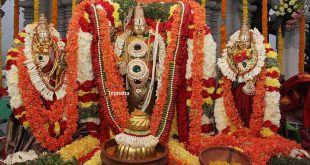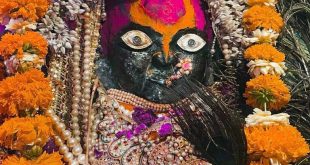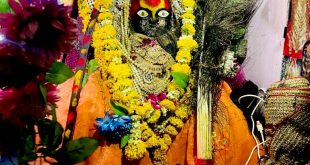Shirdi Sai Baba Samadhi Mandir
The words spoken by Sai Baba – “Do not think I am dead and gone, you’ll hear me from my Shirdi Sai Baba Samadhi Mandir and I shall mentor you” have played their part in guaranteeing that the Samadhi Mandir is the most important place in Shirdi and the main hub of Sai worship and devotion.
Baba has promised “I Shall be active and vigorous even from the tomb” and it is from the Mandir where we experience the happening of Sai Baba and the remarkable way he has touched the hearts and lives of millions of people from all over the world.
Number of devotees visits the Mandir every day to have Baba’s Darshan. People will offer garlands, flowers, fruits or sweets at the time of Darshan. Some may offer the personal items like Shawls, books, keys, cards etc., to obtain Baba’s blessings by offering it at his feet and having it touch his Samadhi. People sing bhajans, chant Sai Baba Ki Jai, or whisper payers. There is no longer the case of busy rush during festival times with the construction of Queue complex.
Baba was never confined to his physical body even before 1918, because he himself said, ‘My guru has already freed me from this body. Whoever thinks that this body is Sai Baba hasn’t seen Sai Baba at all.’ His devotees need some means of interacting with Baba, and because his body had already been released, it was actually a tomb a small, moving, limited tomb that was capable of interacting with a number of people. Then, because he so loves and he wanted to cater to the growing needs of the people, he had to change. So he changed his tomb from that tomb to the present tomb, which is an extension of the one he had before, and is a form of Baba’s body. That is why he said, ‘My tomb will speak, my tomb will move, my tomb will answer,’ just as his physical body had been answering.
The temple houses Baba’s monument was originally constructed as wada during Baba’s last years. The temple is built on some land which tends as a garden. Baba levelled the dumping land and started to grow the plants. Baba used the seeds brought from Rahata and planted jasmine and marigolds. Baba by gardening the land distributed the flowers in the local temples. Now the temple itself is using the flowers from garden for decorating the Guru or the temple.
The temple was built by a multi-millionaire Gopalrao Booty from Nagpur. He was introduced to Baba by S.B. Dhumal about 10 years before Baba Mahasamadhi. The Wada is originally thought to be a rest house and Mandir. The thought of building the temple came to Booty in a dream- Baba appeared and told him to build a house and the temple when he was sleeping beside his friend Shyama. Later Booty woke up and saw Shyama had tears in his eyes and said the same dream and were deeply touched by it. Shyama and Booty drew some rough sketch and showed them to Kakasaheb Dixit for approval. Dixit and both went to baba to ask his permission to go ahead with the plan. Baba responded and gave his warm blessings.
The work was begun in 1915. Shyama supervised the construction of the basement, ground floor and the well. Later Bapusaheb Jog took the responsibility. When baba on his visit to Lendi, he sometime offer some suggestions. After the completion, the foundation was quickly laid, a pedestal prepared and an order placed for the idol.
It is around the time Baba fell ill and his devotees feared the worst. However, Baba was moved into the wada from the mosque in a way that had been seen by others. His health rapidly deteriorated and on 15 October 1918 he lay with his body fading fast. His last words were, “I’m not feeling well in the masjid.Carry me to the dagadi wada.” Baba was indeed carried to the wada, and was buried in the place where the image of Murlidhar was to have been placed.
The day that baba took mahasamadhi, Tuesday 15th October 1918, was very auspicious and holy one in both Hindu and Muslim calendars, the 9th day of Ramzan and on the major Hindu festival of Vijayadasami and also ekadashi had just started. Two months previously Baba had sent a message to Banne Mia fakir, saying that “on the ninth day, of the ninth month, Allah is taking away the lamp he lit”.
The news of Baba’s death spread quickly, and thousands of devotes came to Dwarkamai for a final darshan, queuing for five or six hours. The body was kept on a handcart all night, while the preparations of digging a pit and building the platform went on. Before the burial of Baba, his Kafni was removed and he had given a final bath, at that stage also his body remained soft and was like he is sleeping. Some of the personal things of Baba were buried with him the broken brick, repaired with gold and silver wire, one of his satkas, a chillim, needle and cotton, some spices to preserve the body and an old cloth bag the baba never allowed anyone to touch, but after his death devotees researched the bag and found a green kafni and a cap inside it.
The statue was installed on 7 October 1954, on Vijayadasami day, the 36th anniversary of Baba’s mahasamadhi. The Nandi bull now there in the entrance of the temple was installed later. The royal seat is previously covered with silver, but now it is adorned with gold.
The main worship in Shirdi, the statue is offered all due honours. The devotees and Santhan officials believe that “Baba is still alive”. Devotees wish to offer all sorts of respect and comfort they can. Baba is given bath with hot water in the morning, offer breakfast, lunch and dinner; Baba’s clothes were changed 4 times a day before each Aarthi. Baba is decorated with silver or a gold crown for Aarthi worship. At nights a mosquito net is hung and the tomb is spread with a special plain white cotton cloth, of type that Baba Kafnis are made. A glass of water is kept by his side and each morning at 5:00 AM baba is woken up and mosquito net is removed and incense is offered while Bhupali is sung.
After the first Aarthi of the day, Baba is offered abhishekam. Abhishekam is performed with water, milk, curd, ghee, fruit juices etc. Devotees can sponsor the abhishekam and donate clothes to Baba which will be wrapped around the statue by contacting the Donation office. Later all the clothes that are offered to Baba were put on sale in the Santhan shop which is just a few metres from the Mandir.
 Hotel Booking, Tour and Travel Planning, Online Tickets Tour Planning, Designing Packages, Hotel Booking
Hotel Booking, Tour and Travel Planning, Online Tickets Tour Planning, Designing Packages, Hotel Booking


